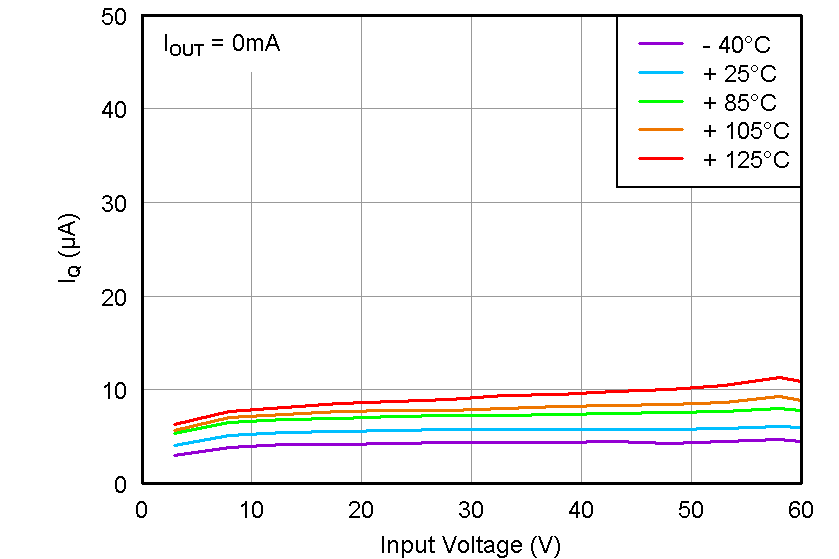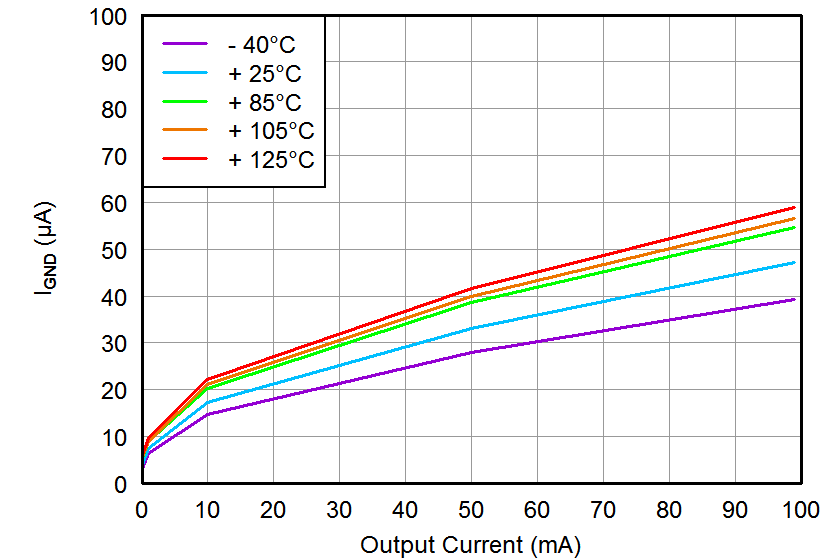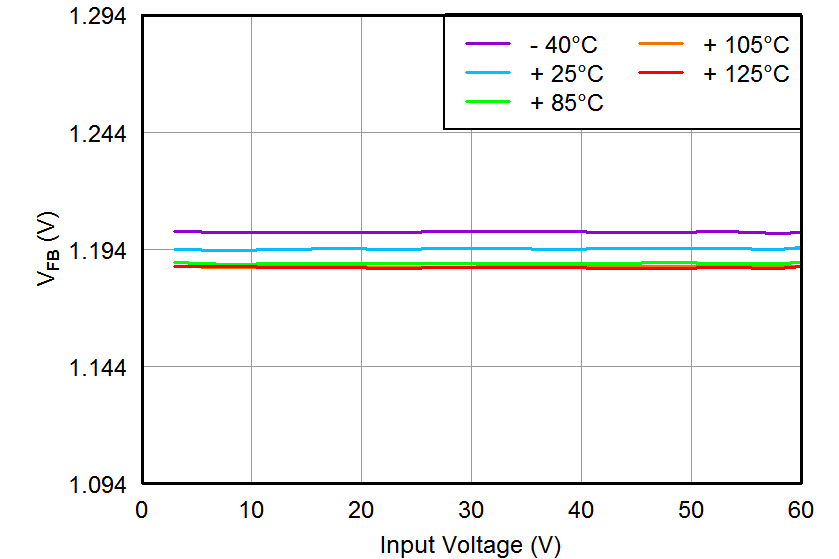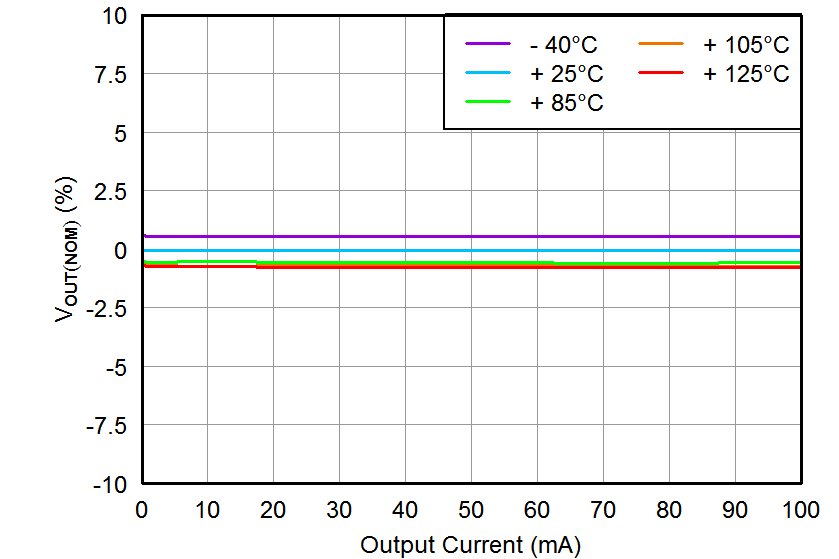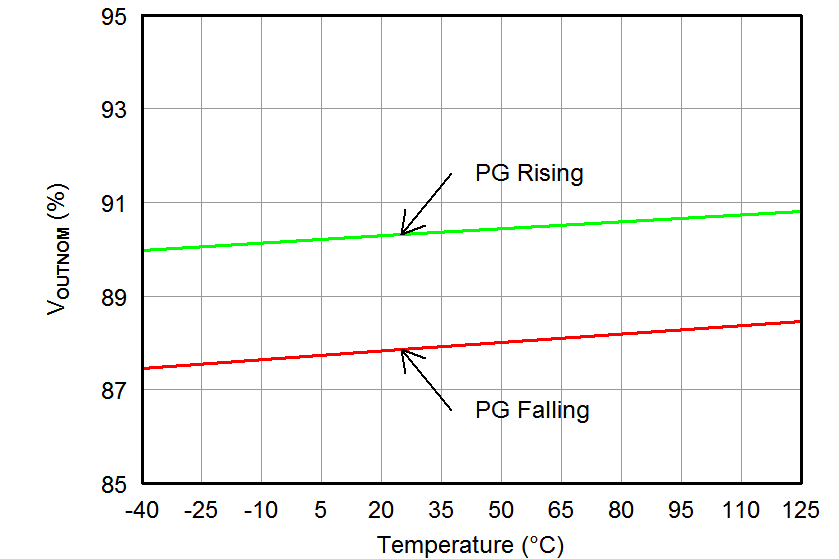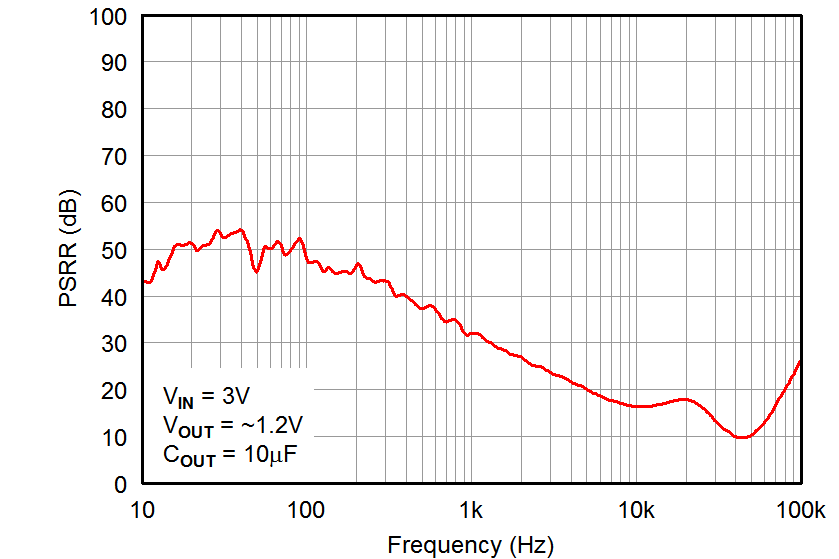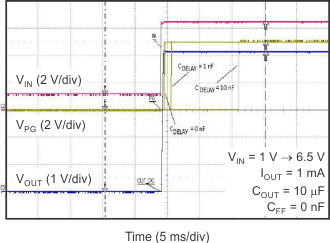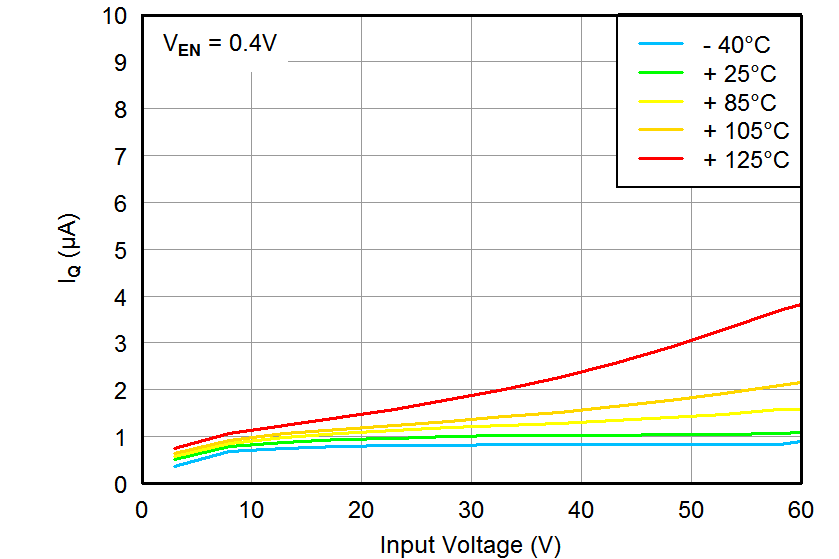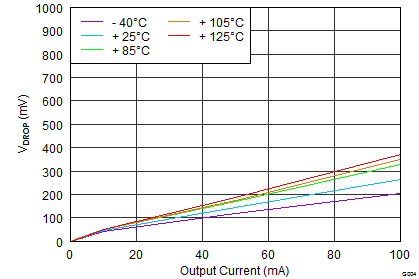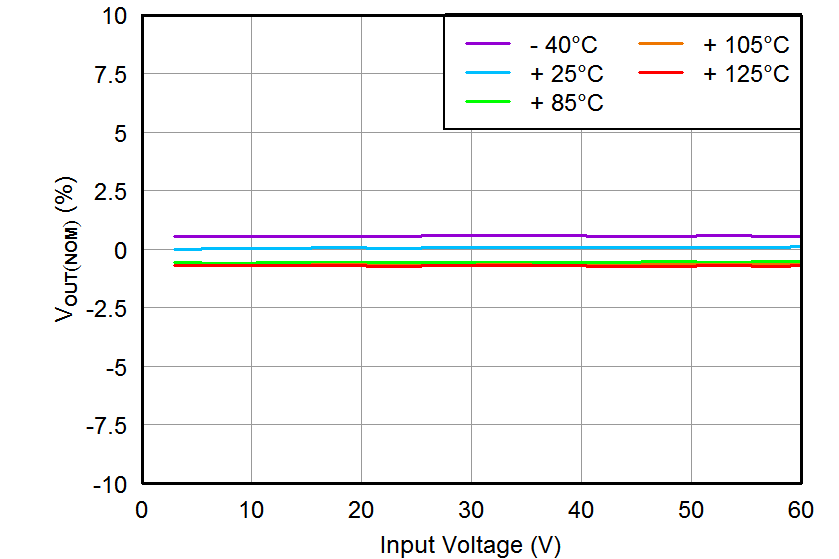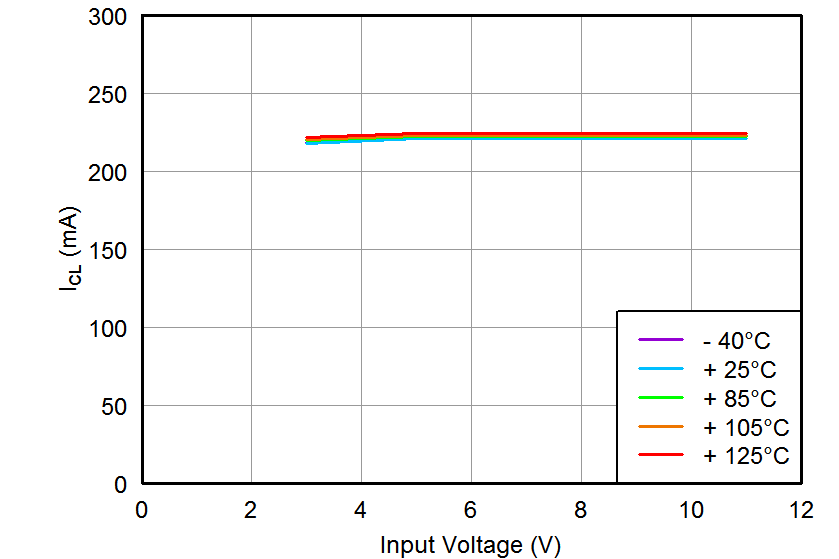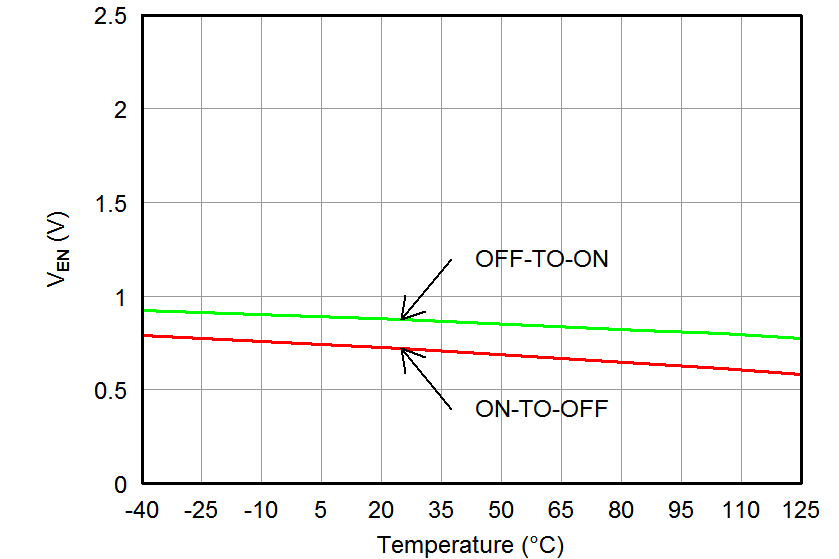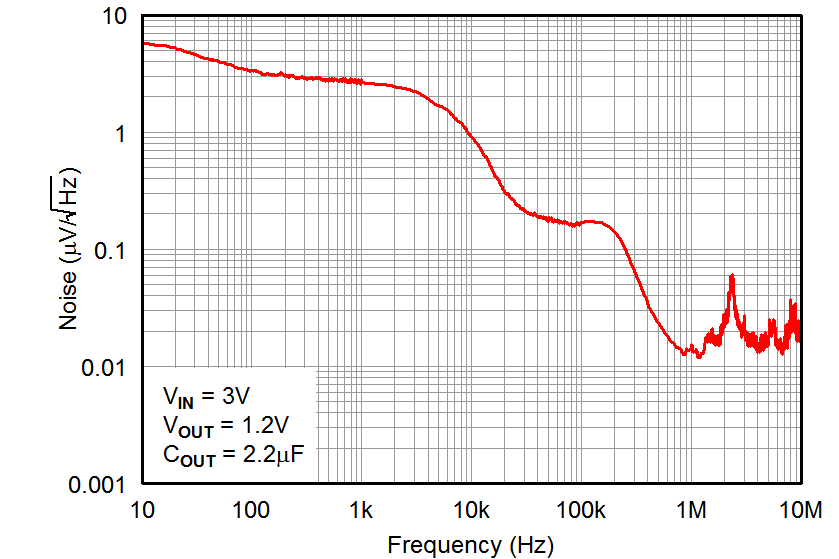ZHCS237F December 2011 – October 2015 TPS7A16
PRODUCTION DATA.
- 1 特性
- 2 应用
- 3 说明
- 4 修订历史记录
- 5 Pin Configuration and Functions
- 6 Specifications
- 7 Detailed Description
- 8 Application and Implementation
- 9 Power Supply Recommendations
- 10Layout
- 11器件和文档支持
- 12机械、封装和可订购信息
封装选项
机械数据 (封装 | 引脚)
散热焊盘机械数据 (封装 | 引脚)
订购信息
6 Specifications
6.1 Absolute Maximum Ratings
Over operating free-air temperature range –40°C ≤ TJ ≤ 125°C (unless otherwise noted).(1)| MIN | MAX | UNIT | ||
|---|---|---|---|---|
| Voltage | IN pin to GND pin | –0.3 | 62 | V |
| OUT pin to GND pin | –0.3 | 20 | ||
| OUT pin to IN pin | –62 | 0.3 | ||
| FB pin to GND pin | –0.3 | 3 | ||
| FB pin to IN pin | –62 | 0.3 | ||
| EN pin to IN pin | –62 | 0.3 | ||
| EN pin to GND pin | –0.3 | 62 | ||
| PG pin to GND pin | –0.3 | 5.5 | ||
| DELAY pin to GND pin | –0.3 | 5.5 | ||
| Current | Peak output | Internally limited | ||
| Temperature | Operating virtual junction, TJ | –40 | 150 | °C |
| Storage, Tstg | –65 | 150 | ||
(1) Stresses beyond those listed under Absolute Maximum Ratings may cause permanent damage to the device. These are stress ratings only, which do not imply functional operation of the device at these or any other conditions beyond those indicated under Recommended Operating Conditions. Exposure to absolute-maximum-rated conditions for extended periods may affect device reliability.
6.2 ESD Ratings
| VALUE | UNIT | |||
|---|---|---|---|---|
| V(ESD) | Electrostatic discharge | Human body model (HBM), per ANSI/ESDA/JEDEC JS-001, all pins(1) | ±2000 | V |
| Charged device model (CDM), per JEDEC specification JESD22-C101, all pins(2) | ±500 | |||
(1) JEDEC document JEP155 states that 500-V HBM allows safe manufacturing with a standard ESD control process.
(2) JEDEC document JEP157 states that 250-V CDM allows safe manufacturing with a standard ESD control process.
6.3 Recommended Operating Conditions
over operating free-air temperature range (unless otherwise noted)| MIN | NOM | MAX | UNIT | ||
|---|---|---|---|---|---|
| VIN | Unregulated input | 3 | 60 | V | |
| VOUT | Regulated output | 1.169 | 18.5 | V | |
| EN | 0 | 40 | V | ||
| DELAY | 0 | 5 | V | ||
| PG | 0 | 5 | V | ||
| TJ | Operating junction temperature range | –40 | 125 | °C | |
6.4 Thermal Information
| THERMAL METRIC(1) | TPS7A1601 | UNIT | ||
|---|---|---|---|---|
| DGN (HVSSOP) | DRB (VSON) | |||
| 8 PINS | 8 PINS | |||
| RθJA | Junction-to-ambient thermal resistance | 66.2 | 44.5 | °C/W |
| RθJC(top) | Junction-to-case(top) thermal resistance | 45.9 | 49.5 | °C/W |
| RθJB | Junction-to-board thermal resistance | 34.6 | 11.3 | °C/W |
| ψJT | Junction-to-top characterization parameter | 1.9 | 0.7 | °C/W |
| ψJB | Junction-to-board characterization parameter | 34.3 | 11.2 | °C/W |
| RθJC(bot) | Junction-to-case(bottom) thermal resistance | 14.9 | 4.7 | °C/W |
(1) For more information about traditional and new thermal metrics, see the Semiconductor and IC Package Thermal Metrics application report, SPRA953.
6.5 Electrical Characteristics
At TJ = –40°C to 125°C, VIN = VOUT(NOM) + 0.5 V or VIN = 3 V (whichever is greater), VEN = VIN, IOUT = 10 µA, CIN = 1 μF, COUT = 2.2 μF, and FB tied to OUT, unless otherwise noted.| PARAMETER | TEST CONDITIONS | MIN | TYP | MAX | UNIT | |||
|---|---|---|---|---|---|---|---|---|
| VIN | Input voltage range | 3 | 60 | V | ||||
| VREF | Internal reference | TJ = 25°C, VFB = VREF, VIN = 3 V, IOUT = 10 μA | 1.169 | 1.193 | 1.217 | V | ||
| VUVLO | Undervoltage lockout threshold | 2.7 | V | |||||
| VOUT | Output voltage range | VIN ≥ VOUT(NOM) + 0.5 V | VREF | 18.5 | V | |||
| Nominal accuracy | TJ = 25°C, VIN = 3 V, IOUT = 10 μA | –2% | 2% | VOUT | ||||
| Overall accuracy | VOUT(NOM) + 0.5 V ≤ VIN ≤ 60 V(1)
10 µA ≤ IOUT ≤ 100 mA |
–2% | 2% | VOUT | ||||
| ΔVO(ΔVI) | Line regulation | 3 V ≤ VIN ≤ 60 V | ±1% | VOUT | ||||
| ΔVO(ΔIO) | Load regulation | 10 µA ≤ IOUT ≤ 100 mA | ±1% | VOUT | ||||
| VDO | Dropout voltage | VIN = 4.5 V, VOUT(NOM) = 5 V, IOUT = 20 mA | 60 | mV | ||||
| VIN = 4.5 V, VOUT(NOM) = 5 V, IOUT = 100 mA | 265 | 500 | mV | |||||
| ILIM | Current limit | VOUT = 90% VOUT(NOM), VIN = 3 V | 101 | 225 | 400 | mA | ||
| IGND | Ground current | 3 V ≤ VIN ≤ 60 V, IOUT = 10 µA | 5 | 15 | μA | |||
| IOUT = 100 mA | 5 | μA | ||||||
| ISHDN | Shutdown supply current | VEN = 0.4 V | 0.59 | 5 | μA | |||
| I FB | Feedback current(2) | –0.1 | –0.01 | 0.1 | µA | |||
| IEN | Enable current | 3 V ≤ VIN ≤ 12 V, VIN = VEN | –1 | –0.01 | 1 | μA | ||
| VEN_HI | Enable high-level voltage | 1.2 | V | |||||
| VEN_LO | Enable low- level voltage | 0.3 | V | |||||
| VIT | PG trip threshold | OUT pin floating, VFB increasing, VIN ≥ VIN_MIN | 85% | 95% | VOUT | |||
| OUT pin floating, VFB decreasing, VIN ≥ VIN_MIN | 83% | 93% | VOUT | |||||
| VHYS | PG trip hysteresis | 2.3% | 4% | VOUT | ||||
| VPG, LO | PG output low voltage | OUT pin floating, VFB = 80% VREF, IPG= 1mA | 0.4 | V | ||||
| IPG, LKG | PG leakage current | VPG= VOUT(NOM) | –1 | 1 | μA | |||
| IDELAY | DELAY pin current | 1 | 2 | μA | ||||
| PSRR | Power-supply rejection ratio | VIN = 3 V, VOUT(NOM) = VREF, COUT = 10 μF, f = 100 Hz |
50 | dB | ||||
| TSD | Thermal shutdown temperature | Shutdown, temperature increasing | 170 | °C | ||||
| Reset, temperature decreasing | 150 | °C | ||||||
| TJ | Operating junction temperature range | –40 | 125 | °C | ||||
(1) Maximum input voltage is limited to 24 V because of the package power dissipation limitations at full load (P ≈ (VIN – VOUT) × IOUT =
(24 V – VREF) × 50 mA ≈ 1.14 W). The device is capable of sourcing a maximum current of 50 mA at higher input voltages as long as the power dissipated is within the thermal limits of the package plus any external heatsinking.
(24 V – VREF) × 50 mA ≈ 1.14 W). The device is capable of sourcing a maximum current of 50 mA at higher input voltages as long as the power dissipated is within the thermal limits of the package plus any external heatsinking.
(2) IFB > 0 flows out of the device.
6.6 Typical Characteristics
At TJ = –40°C to 125°C, VIN = VOUT(NOM) + 0.5 V or VIN = 3 V (whichever is greater), VEN = VIN, IOUT = 10 µA, CIN = 1 μF, COUT = 2.2 μF, and FB tied to OUT, unless otherwise noted.